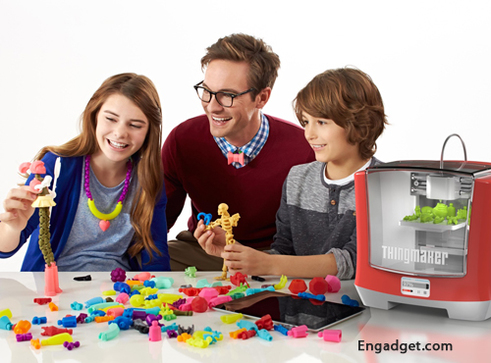The risk-taking toymaker is Mattel, which is introducing to its product line a 3D printer designed for young people age 13 and up. Named “ThingMaker,” the new product pays homage to a 1960s Mattel invention by the same name that allowed children to “create their own toys by pouring liquid plastic into metal molds.”
Not surprising, the 21st century version of ThingMaker is considerably more advanced. For instance, it has fast forwarded to the digital age by working wirelessly with iOS and Android apps so users can design and print directly from their mobile devices. The printer also supports safety by boasting a print head that retracts when inactive so not to burn users. How is the maker of Barbies and Hot Wheels able to manufacture such a technologically sophisticated product? Mattel has partnered with Autodesk, “a leader in 3D design, engineering and entertainment software” that aspires to make 3D printing more accessible.
Of course, little from the preceding paragraph matters to kids—they want to know what they can make, which includes things like jewelry, scorpions, skeletons, and other figurines, many of which have ball-and-socket joints that allow for further customization. What matters to most parents is the price. Surprisingly the printer will only set them back $300, a low price compared to other 3D printers, which can reach thousands of dollars. Like other 3D printer makers, Mattel also stands to make money on consumables, i.e., sales of the PLA plastic filament needed to do the printing.
Maybe 3D printers are important for industrial companies, but do 13-year-old kids really need them? No, they don’t, in as much as toys in general are not “needed”; however, for parents who are willing and able to spend $300 on a plaything, as many are, the ThingMaker may be a relatively small price to pay to cultivate creativity -- a trait that may be disappearing in children, even as employers increasingly desire it.
A study published in Creativity Research Journal, for instance, found a decline in creativity in students’ fictional writing over a recent twenty-year period. Likewise, in 2010, the Torrance Test of Creative Thinking, a well-known measure of creativity, discovered that scores of U.S. respondents had been decreasing regularly. In addition, in a wide survey of adults in the U.S., Europe, and Japan, Adobe found that only 52% of Americans and 39% of global respondents considered themselves creative, while three-quarters of respondents felt they were not fulfilling their creative potential.
The bitter irony is that businesses and other organizations are increasingly eager to hire individuals with creative skills. For instance, IBM’s Institute for Business Value surveyed 1,500 chief executives and saw them identify creativity as “the most important leadership competency for the successful enterprise of the future,” because creative people are capable of disrupting: the status quo, existing business models, and organizational paralysis. Similarly, Careerealism has identified that creative employees tend to offer:
- Solutions for difficult problems
- New opportunities for their organizations
- The right questions
- Broader outlooks and approaches
- Enthusiasm to learn
Can a 3D printer for kids move the needle on creativity in our world? Not by itself, but it may be a meaningful step in the right direction, particularly toward the goal of fostering more creative play among children. As PBS points out, creative experiences for kids shouldn’t be limited to just drawing or painting, they also should include building and making things. PBS also encourages parents and teachers to “buy and use equipment in ways that encourage the use of imagination” and to “avoid toys and activities that spell everything out for the child and leave nothing to the imagination”—sounds like things a 3D printer could support.
It remains to be seen how successful Mattel’s foray into do-it-yourself toys will be. Older and more innovative children may find the capabilities of the company’s initial offering somewhat limiting. However, as the ThingMaker evolves, as it likely will, it should not only cultivate creativity but provide valuable experience with the same technology that more and more people will find themselves using in the workplace (i.e., 3D printing). So, the ThingMaker seems poised to create stakeholder value while also upholding societal values, making Mattel a manufacturer of "Mindful Marketing."
Learn more about the Mindful Matrix and Mindful Meter.
Check out Mindful Marketing Ads and Vote your Mind!




 RSS Feed
RSS Feed